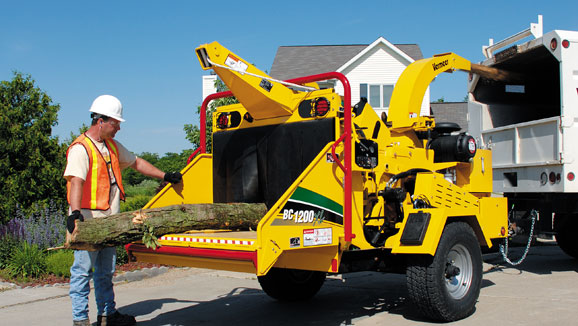Whether you are buying your first brush chipper or your fifth, you need to ask the right questions to find the best fit for your business.
Size
If you plan to specialize in tree trimming, consider a smaller brush chipper. A larger unit generally is needed for contractors performing land-clearing work involving tree takedowns.
A good rule of thumb is to purchase a chipper that can effectively handle at least 80 to 90 percent of the tree and brush you intend to chip. For example, if you plan to process trees where the bulk of the material is 12 to 18 inches (30.5 to 45.7 cm) in diameter, then an 18-inch (45.7 cm) capacity brush chipper would be the recommended model.
Work environment also is a factor. Will you usually be working in confined residential areas with smaller trees, or in green areas with large, mature trees? Whatever the conditions, choosing a chipper that is the right size to do the job is important. Go too small and you risk spending more time maneuvering and handling material and paying higher tipping fees if the logs you take to dumpsites are too large. A chipper that is too big may require a larger truck for transporting it and higher fuel costs — for the truck and the chipper.
Drum or disc
As you choose a chipper, consider whether to get one with a drum- or a disc-cutting mechanism.
Drum chippers were developed to cover wide feed openings and tackle large material, earning a reputation for high productivity, outstanding performance and value. In addition, Drum chippers can also be easier on cutter bearings and typically perform better while chipping palm trees and other materials with string fronds.
When disc chippers were introduced, they were seen as more operator-friendly with infeed roller controls and capable of handling a variety of material of all sizes.
Safety
The safety features on a chipper are as important as size and performance. Longer feed tables provide more distance between the cutters and operators. Look for a model with an enhanced upper feed control bar, which offers an additional emergency stop position. Vermeer brush chippers have a patented bottom feed stop bar at the front of the feed table that can be operated by a worker’s leg in an emergency situation.
Disposal
Another consideration: what you will do with wood debris. There is growing demand for wood chips for uses that include mulch, compost and biofuel. Most companies, however, require a certain chip size, so the type and size of your brush chipper will make a difference.
Ask for help
For help in choosing the chipper that’s best for your business needs, connect with a knowledgeable sales representative from a dealership.
